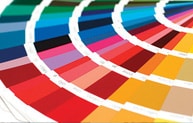Choosing Paint Color Palettes for Your Residential Units and Common Spaces

Q. How do you choose multiple colors for common spaces?
When experimenting with multiple colors, pair colors that share a connection to each other. Opt for colors that sit next to each other on the color wheel, are complementary to each other (violets with yellows, orange hues with blues, for example), or that have the same undertone. This will allow their natural harmonies to create smooth transitions between interior spaces.
Another easy way of creating a palette for common spaces is by selecting various shades from the same color family. Lighter, darker, brighter, or softer versions of the same color can be layered in as accents for a cohesive look.
Q. What types of colors make common spaces feel bigger?
Although color choice is mostly subjective, certain colors have been recognized universally as evocative of particular feelings and reactions that virtually everyone recognizes. Light, cool colors, for instance, tend to create a distancing effect, stretching the perception of proximity and expanding the feel of a room.
Q. What types of colors are associated with luxury?
In the United States, the colors that make a space feel luxurious and sophisticated include black, white, gold, and deep, rich purple.
Q. What do you suggest for improving the durability of a color?
Neutrals (grays, whites, tans, taupes) can significantly expand the life of a wall color. These tones support a wide variety of styles and are easily updated by changing out accent colors.
Q. How do you pair interior unit color with exterior common space color?
Exterior and interior trends evolve at their own pace. For exteriors, color changes are mainly determined by functional factors rather than fashion. In the case of interiors, it depends heavily on the mood and style of the room. To bridge the difference, it’s good practice to keep at least one color in common. Update all other accents as necessary to keep your spaces from feeling dated.
Q. How many colors create a cohesive complex aesthetic?
Three—a main color, trim color, and accent is the industry standard for color combinations.
Q. Is there a rule of thumb for choosing exterior colors versus interior colors?
Due to the large surface areas in exterior applications, color presence comes across with greater intensity outdoors. For this reason, it’s advisable to select neutrals or neutralized colors for outside. Bright colors are best reserved for use on smaller surfaces, as accents.
Q. Once our colors have been determined, what finishes work for an interior space?
Selecting the right interior sheen largely depends on the use and condition of the room. Matte finishes, such as flat and eggshell, are great for use in low-traffic areas, or when the walls have imperfections one would like to hide. Higher sheens, such as satin and semi-gloss, provide greater durability and scrubbability, and are excellent choices for high-traffic areas. They’re not ideal, however, for walls with uneven textures or blemished surfaces.
Q. How should door colors be chosen for units?
Apartment door colors can be conservative or expressive as desired. Black, brown, charcoal, beige, and white are the classic door color choices for their neutrality and versatility. However, if the complex management permits, awe-inspiring door colors like red, coral, aqua, yellow, or even bright green provide a fun punch of color and can be useful for distinguishing floors and/or units. Remember, front doors are the first impression of the home, so be sure it’s a good one.
Source: multifamilyexecutive.com















 Accessibility
Accessibility